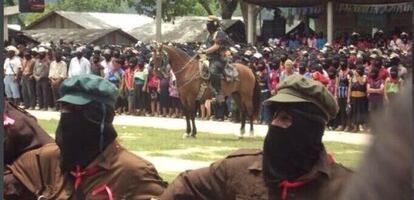After five-year absence, Mexican rebel leader reappears with new identity
Zapatista spokesman changes name to pay tribute to comrade killed in battle


Subcomandante Marcos has died. He announced his death himself – or rather, Rafael Guillén Vicente, the man who created the character of Marcos when he emerged from the jungle in Chiapas in January 1994 to take part in the Zapatista National Liberation Army (EZLN) uprising against the Mexican government, did.
After five years of retirement full of speculation about his health, Guillén has reemerged. On May 2 he attended an event to pay homage to the late José Luis “Galeano” Solís López, a Zapatista teacher who was killed in La Realidad. Then on Sunday morning, he held a press conference to announce the retirement of his rebel character Marcos, who has now become the Insurgent Subcomandante Galeano.
In December 2007 Marcos said he would be retiring from politics “for a good while.” Since then, he has made few appearances in public. In January 2014 the Zapatistas celebrated the 20th anniversary of the armed revolt with a number of events, but Marcos did not attend. The absence of the most recognizable face of the movement fanned the rumors: the rebel leader was in poor health. But now, Marcos has returned to belie the hearsay.
“I am not and I have not been sick. I am not and I have not been dead,” the rebel soldier said. “We fed those rumors because it was convenient for us.” Marcos wore a pirate’s patch over his right eye as he read the message to the media. His speech was a long look back over the 20-year-old movement and his role in it. “Marcos went from being a spokesman to a distraction. If you allow me to define that old Marcos, I would say, without hesitation, that he was a clown,” he said.
If you allow me to define that old Marcos, I would say that he was a clown”
The return of the hooded rebel is not without cause. His message comes just a few weeks after violence shook up the Zapatistas. The top brass of the EZLN accompanied him to the event to honor Galeano. Subcomandante Moisés was the main speaker.
José Luis “Galeano” Solís died on May 2 during skirmishes between EZLN forces and a faction of the workers and peasant group, Central Independiente de Obreros Agrícolas y Campesinos Histórica (CIOAC-H). There has been bad blood between the Zapatistas and the CIOAC-H for years. The two groups have been fighting for more than a decade over control of certain roads and highways that connect different towns in the indigenous region of Chiapas, in southern Mexico. They had agreed to start dialogue but on May 2 relations degenerated into clashes.
Solís, a long-serving Zapatista figure who took over two municipalities in the 1994 armed uprising, borrowed his nickname from Uruguayan writer Eduardo Galeano. For years he taught classes at La Escuelita, an EZLN indoctrination project for children in areas under insurgent command.
Marcos wore a black armband in mourning for Galeano. “When they murder him or any other Zapatista, it is a sign that those from above are trying to kill the EZLN,” he said. “In order for Galeano to live, we think that one of us must die… So we have decided that Marcos will cease to exist today.”
The last Mexican rebel soldier of the 20th century died at 2.08am “in combat on the southeastern front.” That same morning the Insurgent Subcomandante Galeano was born.
Translation: Dyane Jean François
Tu suscripción se está usando en otro dispositivo
¿Quieres añadir otro usuario a tu suscripción?
Si continúas leyendo en este dispositivo, no se podrá leer en el otro.
FlechaTu suscripción se está usando en otro dispositivo y solo puedes acceder a EL PAÍS desde un dispositivo a la vez.
Si quieres compartir tu cuenta, cambia tu suscripción a la modalidad Premium, así podrás añadir otro usuario. Cada uno accederá con su propia cuenta de email, lo que os permitirá personalizar vuestra experiencia en EL PAÍS.
¿Tienes una suscripción de empresa? Accede aquí para contratar más cuentas.
En el caso de no saber quién está usando tu cuenta, te recomendamos cambiar tu contraseña aquí.
Si decides continuar compartiendo tu cuenta, este mensaje se mostrará en tu dispositivo y en el de la otra persona que está usando tu cuenta de forma indefinida, afectando a tu experiencia de lectura. Puedes consultar aquí los términos y condiciones de la suscripción digital.
Últimas noticias
Reinhard Genzel, Nobel laureate in physics: ‘One-minute videos will never give you the truth’
Pinochet’s victims grapple with José Antonio Kast’s rise in Chile
How Japan is trying to avert ‘digital defeat’
The complicated life of Francesca Albanese: A rising figure in Italy but barred from every bank by Trump’s sanctions
Most viewed
- Pablo Escobar’s hippos: A serious environmental problem, 40 years on
- Why we lost the habit of sleeping in two segments and how that changed our sense of time
- Trump’s obsession with putting his name on everything is unprecedented in the United States
- Charles Dubouloz, mountaineering star, retires at 36 with a farewell tour inspired by Walter Bonatti
- The Florida Keys tourist paradise is besieged by immigration agents: ‘We’ve never seen anything like this’








































